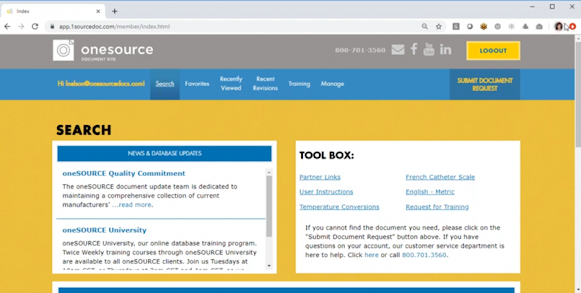Martin Li, MA, CRCST, CER, CIS, CHL
The oneSOURCE Document Library is a critical resource in the
Sterile Processing Department (SPD), instrumental in ensuring compliance,
optimizing equipment use, and enhancing patient safety. It offers comprehensive
access to key documents such as Instructions for Use (IFUs), Cleaning
Protocols, Service Manuals, and Safety Data Sheets (SDS). These resources are
indispensable for training staff and maintaining high standards in
sterilization processes and operational efficiency. Below is a detailed overview
of how I utilized the oneSOURCE Document Library to train SPD staff
effectively.
Key Features of the oneSOURCE Document Library
- Instructions
for Use (IFUs): Detailed guidelines on the correct and safe use of
medical devices, specific to their manufacturer requirements.
- Cleaning
Protocols: Step-by-step instructions for cleaning and sterilizing
medical equipment to meet regulatory standards.
- Service
Manuals: Technical documents providing maintenance and repair
instructions for medical devices, ensuring proper equipment functionality.
- Safety
Data Sheets (SDS): Essential information regarding the safe handling,
storage, and disposal of hazardous materials used in medical settings.
These documents are critical in ensuring that SPD staff
follow standardized procedures, comply with stringent regulatory requirements,
and maintain patient safety. Below is how I incorporate these resources into my training programs.
Training Strategies
1. Training Sessions
- Interactive
Demonstrations: I use the oneSOURCE Document Library during hands-on training to demonstrate real-time examples of IFUs and cleaning protocols.
By showing these documents on-screen or distributing printed copies, staff
can clearly see the manufacturer’s instructions. This approach
allows them to grasp the importance of following precise, documented
guidelines for each device and instrument.
- Case
Studies: I integrate real-world case studies where improper
sterilization led to adverse outcomes, such as equipment contamination or
patient infections. Using the OneSource library, I walk through the
correct protocols that should have been followed, reinforcing the
importance of adherence to established procedures and showing how critical
errors can be avoided.
2. Regular Updates
- Monthly
Workshops: To keep staff up-to-date with industry standards, I hold
monthly workshops reviewing newly added documents or updated guidelines in
the library. This ensures that all team members are informed about the
latest best practices and are applying them consistently in the
department.
- Quizzes
and Assessments: Following training sessions or workshops, I develop
quizzes based on the updated documents from the oneSOURCE library. These
assessments test and reinforce the knowledge acquired by staff, ensuring
they retain the critical information required for daily operations.
3. Daily Use
- Accessible
Stations: I install computer stations throughout the SPD where staff
can access the oneSOURCE library at any time. This setup allows them to
reference IFUs and cleaning protocols quickly when they encounter
uncertainty during a task, empowering them to perform their roles with
confidence and accuracy.
- Checklists:
I create detailed checklists derived from the protocols in the oneSOURCE
library. These checklists are used as quick-reference guides during daily
sterilization tasks, ensuring that no critical steps are missed in
cleaning and sterilization processes, which helps maintain compliance with
industry standards.
4. Feedback and Continuous Improvement
- Feedback
Sessions: I regularly hold feedback sessions with staff, encouraging
them to share their experiences with the oneSOURCE library. This process
identifies any challenges or areas of confusion. Staff feedback is
invaluable for refining training programs and improving the usability of
the document library.
- Continuous
Improvement: By fostering a culture of continuous improvement, I
encourage staff to suggest updates or modifications to procedures based on
their experiences and the latest information in the library. This
iterative process helps the department stay agile and responsive to new
developments in sterilization practices and technology.
Example Training Session: High-Temperature Sterile
Processing
Objective:
To train SPD staff on the best practices for
high-temperature sterilization, ensuring compliance with safety regulations and
the safeguarding of patient safety.
Duration:
1 hour 20 minutes
Materials Needed:
- Access
to the oneSOURCE Document Library
- Sterilization
equipment (e.g., autoclaves)
- Sample
instruments and trays
- Projector
and screen for presentations
- Handouts
with key protocols and checklists
Agenda:
- Introduction
(5 minutes): Provide an overview of the session’s objectives and
emphasize the importance of high-temperature sterilization in infection
control.
- Overview
of Sterilization (5 minutes): Discuss the definition, types of
sterilization (e.g., steam sterilization), and explain how high
temperatures effectively eliminate microorganisms.
- Equipment
Overview (10 minutes): Demonstrate the components and safety features
of autoclaves, and explain the importance of regular maintenance.
- Sterilization
Process (10 minutes):
- Cleaning
and decontaminating instruments
- Inspecting
and assembling instruments
- Best
practices for loading autoclaves and selecting the correct sterilization
cycle based on instrument specifications
- Hands-On
Practice (10 minutes): Allow staff to practice loading and operating
autoclaves, referencing IFUs and cleaning protocols directly from the
oneSOURCE Document Library in real-time.
- Post-Sterilization
Procedures (5 minutes): Teach staff how to safely unload autoclaves,
inspect sterilized instruments for cleanliness and damage, and complete
necessary documentation.
- Compliance
and Quality Assurance (10 minutes): Review regulatory standards and
discuss common challenges, providing tips for continuous quality
improvement.
- Q&A
and Discussion (10 minutes): Encourage staff to discuss real-world
problems they’ve encountered and apply the training content to these
scenarios.
- Assessment
and Feedback (10 minutes): Administer a brief quiz and collect
feedback on the training session to improve future programs.
Handouts:
- Step-by-step
checklists for pre-sterilization, sterilization, and post-sterilization
procedures
- Key
points from the oneSOURCE Document Library relevant to high-temperature
sterilization
- A
troubleshooting guide for common issues with autoclaves
Conclusion
By integrating the oneSOURCE Document Library into my
training programs and daily operations, I ensure that SPD staff remain
knowledgeable, compliant with regulations, and capable of maintaining the
highest standards in sterilization and patient safety. This resource has proven
to be an indispensable tool, supporting continuous skill development and
knowledge enhancement within our department. It empowers staff to perform their
duties with precision and confidence, ultimately improving the quality of care
provided to patients.





No comments:
Post a Comment